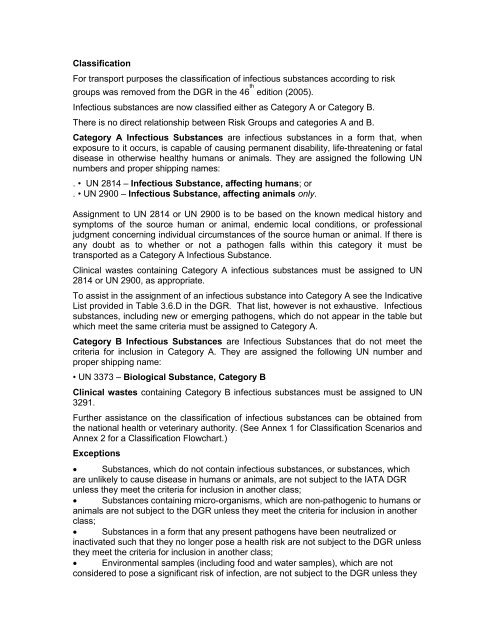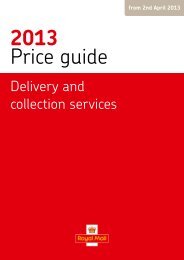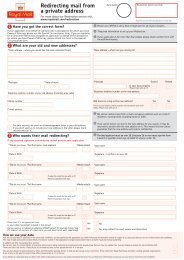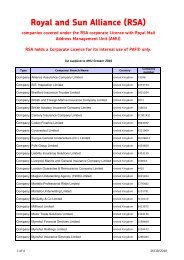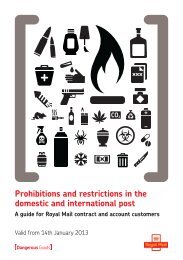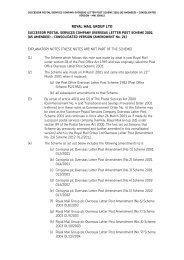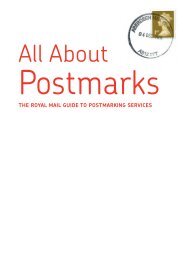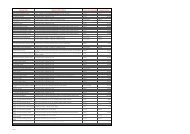IATA Guidance Document on Infectious Substances - Post Office
IATA Guidance Document on Infectious Substances - Post Office
IATA Guidance Document on Infectious Substances - Post Office
You also want an ePaper? Increase the reach of your titles
YUMPU automatically turns print PDFs into web optimized ePapers that Google loves.
Classificati<strong>on</strong><br />
For transport purposes the classificati<strong>on</strong> of infectious substances according to risk<br />
groups was removed from the DGR in the 46 th editi<strong>on</strong> (2005).<br />
<strong>Infectious</strong> substances are now classified either as Category A or Category B.<br />
There is no direct relati<strong>on</strong>ship between Risk Groups and categories A and B.<br />
Category A <strong>Infectious</strong> <strong>Substances</strong> are infectious substances in a form that, when<br />
exposure to it occurs, is capable of causing permanent disability, life-threatening or fatal<br />
disease in otherwise healthy humans or animals. They are assigned the following UN<br />
numbers and proper shipping names:<br />
. • UN 2814 – <strong>Infectious</strong> Substance, affecting humans; or<br />
. • UN 2900 – <strong>Infectious</strong> Substance, affecting animals <strong>on</strong>ly.<br />
Assignment to UN 2814 or UN 2900 is to be based <strong>on</strong> the known medical history and<br />
symptoms of the source human or animal, endemic local c<strong>on</strong>diti<strong>on</strong>s, or professi<strong>on</strong>al<br />
judgment c<strong>on</strong>cerning individual circumstances of the source human or animal. If there is<br />
any doubt as to whether or not a pathogen falls within this category it must be<br />
transported as a Category A <strong>Infectious</strong> Substance.<br />
Clinical wastes c<strong>on</strong>taining Category A infectious substances must be assigned to UN<br />
2814 or UN 2900, as appropriate.<br />
To assist in the assignment of an infectious substance into Category A see the Indicative<br />
List provided in Table 3.6.D in the DGR. That list, however is not exhaustive. <strong>Infectious</strong><br />
substances, including new or emerging pathogens, which do not appear in the table but<br />
which meet the same criteria must be assigned to Category A.<br />
Category B <strong>Infectious</strong> <strong>Substances</strong> are <strong>Infectious</strong> <strong>Substances</strong> that do not meet the<br />
criteria for inclusi<strong>on</strong> in Category A. They are assigned the following UN number and<br />
proper shipping name:<br />
• UN 3373 – Biological Substance, Category B<br />
Clinical wastes c<strong>on</strong>taining Category B infectious substances must be assigned to UN<br />
3291.<br />
Further assistance <strong>on</strong> the classificati<strong>on</strong> of infectious substances can be obtained from<br />
the nati<strong>on</strong>al health or veterinary authority. (See Annex 1 for Classificati<strong>on</strong> Scenarios and<br />
Annex 2 for a Classificati<strong>on</strong> Flowchart.)<br />
Excepti<strong>on</strong>s<br />
• <strong>Substances</strong>, which do not c<strong>on</strong>tain infectious substances, or substances, which<br />
are unlikely to cause disease in humans or animals, are not subject to the <str<strong>on</strong>g>IATA</str<strong>on</strong>g> DGR<br />
unless they meet the criteria for inclusi<strong>on</strong> in another class;<br />
• <strong>Substances</strong> c<strong>on</strong>taining micro-organisms, which are n<strong>on</strong>-pathogenic to humans or<br />
animals are not subject to the DGR unless they meet the criteria for inclusi<strong>on</strong> in another<br />
class;<br />
• <strong>Substances</strong> in a form that any present pathogens have been neutralized or<br />
inactivated such that they no l<strong>on</strong>ger pose a health risk are not subject to the DGR unless<br />
they meet the criteria for inclusi<strong>on</strong> in another class;<br />
• Envir<strong>on</strong>mental samples (including food and water samples), which are not<br />
c<strong>on</strong>sidered to pose a significant risk of infecti<strong>on</strong>, are not subject to the DGR unless they


